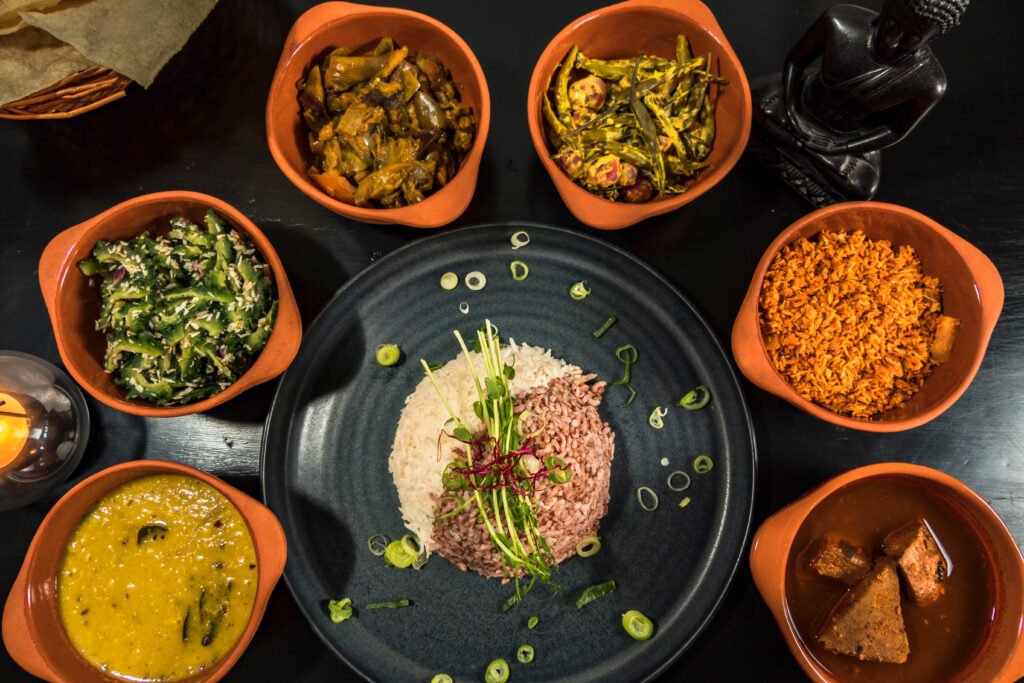The Spice Roots That Shaped a Nation
Long before modern restaurants and street food stalls, Sri Lanka was a coveted source of spices. Cinnamon, cardamom, cloves, nutmeg, and black pepper were traded with kingdoms from the Middle East, Europe, and Asia, earning the island its historical nickname of Serendib. Visiting spice gardens today, you can walk through plantations fragrant with earthy aromas, touch the bark of cinnamon trees, pluck leaves of cardamom, and learn how these spices were once harvested by hand. These gardens are living classrooms where history is experienced through the senses, and travelers gain insight into how spices not only shaped global trade but also the very essence of Sri Lankan cooking.
Traditional Recipes Passed Through Generations
Every region of Sri Lanka has a signature culinary story. In the northern and eastern provinces, meals are vibrant, often incorporating coconut milk, chili, and tamarind in a delicate balance. Coastal towns showcase seafood dishes prepared fresh from the day’s catch, sometimes grilled over open flames with aromatic herbs. Inland, the central highlands emphasize hearty rice and curry meals infused with fresh garden spices and locally grown vegetables. Families have preserved these recipes for generations, and some villages offer cooking experiences that allow visitors to learn authentic preparation methods, from grinding spices with traditional tools to rolling hoppers over clay stoves. Every dish tells a story of local ingredients, agricultural cycles, and centuries-old traditions.
Street Food That Awakens the Senses
Sri Lanka’s streets are alive with culinary energy. Wandering through local markets, travelers encounter sizzling wades, freshly steamed string hoppers, spicy kottu roti, and sweet pittu that fills the air with a warm, inviting scent. Vendors often prepare meals in small, open-air kitchens, giving an intimate glimpse into everyday life. Sampling these street delights is more than just tasting food; it is a window into community, rhythm, and hospitality. Each bite connects travelers with local customs, encouraging conversations with chefs who carry forward recipes and flavors that have been perfected over generations.
Festivals and Food as Celebration
Culinary experiences in Sri Lanka are closely tied to ritual and celebration. During Vesak, Diwali, and Sinhala and Tamil New Year, the island comes alive with elaborate sweets, coconut-based delicacies, and ceremonial dishes. Rice and milk-based creations are decorated with care, shared among family and community members, and infused with symbolism and gratitude. Participating in these celebrations allows travelers to see food as an art form and a communal practice, where every flavor carries cultural meaning. These moments make clear that in Sri Lanka, eating is rarely just about sustenance; it is about connection, tradition, and storytelling.
Tea Culture Beyond the Cup
No culinary journey in Sri Lanka is complete without exploring its tea heritage. The central highlands, with their rolling plantations and colonial estates, offer not just a sip of the world-famous Ceylon tea, but a full sensory experience. Guided tours reveal the journey from leaf to cup, with explanations of plucking techniques, fermentation, and drying processes. Tea tasting sessions are accompanied by descriptions of the terroir, elevation, and processing methods, which influence subtle flavors and aromas. For travelers, tea is both a cultural ritual and a reminder of how geography and history shape flavor. High tea in a colonial-era hotel or a small estate bungalow offers an elegant moment to pause, reflect, and appreciate the deep roots of Sri Lanka’s culinary identity.
The Fusion of History and Modern Creativity
Sri Lanka’s culinary landscape is continually evolving, with modern chefs drawing inspiration from age-old traditions. Restaurants in Colombo and boutique eateries in coastal towns reinterpret classic recipes with contemporary presentation, blending local ingredients with global techniques. From fusion curries to reinvented seafood dishes, travelers experience creativity grounded in heritage. These dining experiences complement hands-on cooking classes and visits to spice gardens, offering a full spectrum of culinary discovery. The blend of historical authenticity and contemporary innovation ensures that every meal becomes a journey, a story, and a memory.
Connecting With Local Communities Through Food
The most rewarding culinary experiences often involve direct interaction with local communities. Village tours, home-cooked meals, and artisanal workshops offer intimate encounters with the people behind the food. Travelers learn not only recipes but also the cultural context, agricultural knowledge, and familial stories that sustain culinary traditions. These exchanges cultivate appreciation for sustainability, local produce, and the artistry embedded in everyday cooking. For those seeking meaningful travel, food becomes a bridge between cultures, an accessible entry point to understand history, environment, and social life.
Planning Your Culinary Journey in Sri Lanka
A well-designed culinary itinerary allows travelers to experience the full diversity of Sri Lanka’s food culture. From northern coastal spices to southern seafood, from central highland teas to traditional village recipes, every region offers unique tastes and textures. Working with a travel specialist or heritage tour company ensures access to authentic experiences, guided visits, and immersive workshops. The journey becomes more than sightseeing; it becomes an intimate exploration of heritage, flavor, and human creativity.
Sri Lanka’s culinary trails reveal a world where food, culture, and history intertwine. Every dish, market, and festival offers insight into centuries of human ingenuity and regional identity. For travelers willing to slow down and savor both flavors and stories, the island provides an unforgettable journey through taste, aroma, and culture. Whether wandering spice gardens, learning family recipes, or tasting the freshest seafood on a sunlit coast, Sri Lanka invites every visitor to engage all senses in the most delicious and memorable ways.

